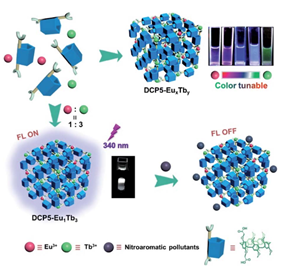On January 21, 2020, the 2017 master student Li Xiangshuai under the guidance of Professor Han Junyou of our school published a research paper on the international authoritative journal Journal of Materials Chemistry A with the title of "A color-tunable fluorescent pillararene coordination polymer for efficient pollutant detection". The instructors are Professor Yang Yingwei from the School of Chemistry, Jilin University and Professor Qin Jianchun from the School of Plant Sciences, Jilin University. JMCA is a highly influential international journal under the Royal Society of Chemistry (RSC), JCR zone: Material Science Area 1, IF = 10.733 .
Nitroaromatic compounds can often be used in the production of explosives and pesticides. They are a common type of pollutant harmful to humans and the environment. Such pollutants usually have moderate vapor pressure and reactivity, making it difficult to monitor. Therefore, there is an urgent need to develop a new type of sensor that can effectively detect such nitroaromatic pollutants to help people effectively monitor such pollutants and avoid their harm.
In order to solve the above problems, the joint team of Professor Yang Yingwei, Professor Han Junyou, and Professor Qin Jianchun used a double carboxyl column [5] aromatic hydrocarbon (DCP5) as the ligand, and europium ion (Eu3+) and terbium ion (Tb3+) as the center. Coordinating ions, a new type of columnar aromatic hydrocarbon coordination polymer (PCP) DCP5-EuxTby with adjustable fluorescence color was constructed. What is interesting is that when the added Eu3+:Tb3+ molar concentration ratio is adjusted to 1:3, white can be obtained Fluorescence emission DCP5-Eu1Tb3, this new type of sensor can effectively detect nitro aromatic pollutants in animals and plants.

Figure 1. The construction route of the columnar aromatic coordination polymer DCP5-EuxTby and the schematic diagram for the detection of nitroaromatic pollutants. (Image source: J. Mater. Chem. A)

Figure 2. The detection ability of DCP5-Eu1Tb3 on nitrobenzene (NB), 2-nitroaniline (2-NA) and trinitrophenol (TNP). (Image source: J. Mater. Chem. A)
During the master's degree, the student was mainly engaged in research in the intersection of plant science and supramolecular science, and published 3 SCI research papers. The other two are: Mater. Chem. Front. 2019, 3, 103-110 (Cite Score = 7.00 ), and Chem. Commun. 2019, 55, 14099-14102 (IF = 6.164).
